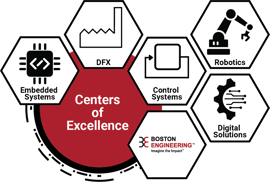Device Feedback and Customer Data: Built on Basic Functional (re)Design
The promise of insight from customer data and machine learning rests on product designs that can capture and communicate user information.
In order to make full use of customer data to improve products, existing products must collect and provide the details, a process we're calling Product Based Digital Feedback. Many consumer products and much of today's manufacturing equipment is still not "smart" - it doesn't communicate with the rest of the world - which leaves a big gap in available data.
Designing or redesigning products to include digital feedback - data collection and communication capabilities - will add much more insight into your products and processes. Leverage existing technologies along with existing networks or products to share data for a more wholistic view of your products will create a lasting competitive advantage for most companies.
What capability designs will have the largest impact?
As with all discussions of largest, best, biggest, or most: It depends on the product and related factors. Those factors include the current product design and capabilities, the market and users, the type of data available and how you need to collect it, where the product is used, and more. The trick is to work to find the best combination and balance to reach the information needs of your organization. Here are several potential areas of focus to consider, along with potential impacts:
Smart vs. Dumb devices: Does you product currently have electronics, Wi-Fi or Bluetooth capabilities, and sensors? Do users interact with the device through a screen or series of input devices? If not, then smartening up your devices is a pre-requisite for taking advantage of digital feedback. Your current design may include precursors to this ability, such as sensors or control systems that capture and use data. To make this a complete system capable of providing streams of data, communication abilities must be included.
Networked vs. Isolated devices: Does your product have the communications ability, but currently sits isolated from other devices? Can you use the existing communication abilities of other device in an existing network to transfer data? There are options to consolidate data collection and transfer through existing network nodes. Further, communication between and with other connected devices will give a depth of data that can be used to analyze product use, as well as details about other related activities in the area of your device.
Individual Feedback or System Level detail: Is the data collected in conjunction with feedback from other sensors, or is it again isolated from the larger system? Additional layers of data will provide additional levels of insight on your product and its usage. If the feedback remains focused on just the single device, there are limits to the detail and insight you'll receive, even with the most advanced AI Systems making sense of it all.

What updates/inclusions should be made to product designs?
Again, each opportunity depends on the existing product or application and the related factors. Here are three potential areas of focus to consider, along with potential impacts.- Networking Systems with Digital Solutions: regardless of how you decide to collect and relay data, the system must be built on a solid background of software and integration with your existing platforms to receive and analyze the digital feedback. Be careful to review integration options and design one that works with your current level of digital transformation.
- Integration with Control Systems: most devices that have the ability to collect user data also incorporate a control system to ensure proper performance. A focus on leveraging the existing data collection and analysis done through these existing systems can make for a smoother transition, including fewer resources and less time to bring an upgraded product to market.
- Including an Embedded System: designing and implementing a custom embedded system will often provide a specific, well structured solution to the problem of capturing and relaying the data you need. Full customization ability with a new embedded system means you can control the exact actions of your device in collecting feedback, including power consumption, timing, networking, connectivity, and all other aspects of computing needed to collect your user data. The use of an embedded system in the design may prove to be the most effective way to both collect and communicate today's data, while also providing a platform for future upgrades to face tomorrow's challenges.

What impacts will integration of digital feedback data have on your product design?

Understanding the importance of the Digital Feedback Process
Ready to realize your bold vision?
 Whether you’ve created a new technology, or have an innovative way to use an existing solution, Boston Engineering has transformed hundreds of bold and improbable ideas into indispensable products with the insights gained through our Centers of Excellence. No matter the challenge, our team possesses the knowledge, expertise, and proven processes you need to bring your vision to life.
Whether you’ve created a new technology, or have an innovative way to use an existing solution, Boston Engineering has transformed hundreds of bold and improbable ideas into indispensable products with the insights gained through our Centers of Excellence. No matter the challenge, our team possesses the knowledge, expertise, and proven processes you need to bring your vision to life.
No matter the challenge, our team possesses the expertise in the engineering disciplines and technologies you need to bring your vision to life. Impossible Challenge? Try Us.
Imagine your Impact: Stay up-to date- with the latest insights and trends we're watching. Add your email address below and sign up for a Monthly Summary of our most impactful posts!












